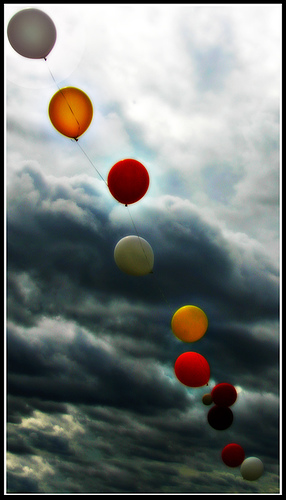Your Life Flashing before Your Eyes
Has it ever happened to you—had your life flash before your eyes? What about one of your characters in your novel—has it happened to her? Think about a character in a story—let’s say a mother sitting in church waiting for her daughter to come down the aisle in her beautiful white wedding gown. This is a key moment in this mother’s life. All the years she spent raising her daughter have brought them both to this moment. Perhaps she’s regretted the way she raised her, feeling she’s been a failure as a mother. Maybe she’s suffering from empty nest syndrome. Whatever this character is feeling at this key moment in her life in the story can be heightened by the use of a montage scene, which is what we began looking at in last week’s post.
As the daughter begins her long walk toward her anxious husband-to-be, she may think back to her daughter as an infant. Then she might recall her first baby steps, then holding her hand as she walked her to her first day at kindergarten. Then there was the time she starred in the sixth-grade musical, and learned how to drive a car (wasn’t that a near-disaster!), and then high school graduation, her senior prom, her first date. Think how many things often flash through your mind when reminded of an important time or person in your life. What happens when you run into someone you haven’t seen in ten years? What if that person was your first love—or your violent ex-spouse?
Memories Appear Often to Us as Montages
Your characters can and should think the way humans normally do, and often we experience a montage of memories. And they don’t have to be memories; they can be “what ifs.” Thoughts of what might happen if I make this choice. Your character can envision all the possibilities of an action. What about a mother whose child has been kidnapped, as we saw in the novel Predator in an earlier post? Can you picture a montage of thoughts going through her head—the worst possible thoughts she doesn’t want to consider?
So whether you want to fast-forward time in your novel or flip through the memories of the past, using a montage technique may serve your story best.
Speeding Up Time
Take a look at this short excerpt from the movie The Conspiracy Theory written in 1996 by Brian Helgeland. In just a short bit of time and with just a few key montage images, we get a very good picture of this paranoid man named Jerry. Mel Gibson plays this role exceptionally well, demonstrating the manic, erratic behavior that makes the viewer wonder just how nuts Jerry really is. Of course, as the plot unfolds, we realize why Jerry is so messed up. In this very early scene, the screenwriter is able to pack in a lot of information by utilizing this camera shot.
INT. APARTMENT- JERRY’S BEDROOM – NIGHT
Carrying a bowl of tapioca, Jerry enters. More files, a manual typewriter. On the wall, an American flag alongside a poster of John Lennon reading: “Assassinated 12/8/80.”
He strides to his desk and a . . .
PUBLISHING MONTAGE BEGINS
Jerry scans a New York Times spread on a drafting table. He circles headlines, names and dates. Does the same with the San Francisco Chronicle, Le Monde, Time, the Economist and Popular Mechanics. He enters raw data on 3×5 cards: space shuttle launched, base closings, escape from mental hospital and especially the obituaries. Specifically: “Industrialist Ernest Hariman Drowns.”
Jerry flips through 100s of cards on big Rolodexes as he cross-references data. Jerry pulls cards, lines them up. The first connection: the dates of six Space Shuttle launches and six earthquakes all coinciding. Jerry lets out a low whistle. Never too jaded to be shocked.
Jerry types the text of an article, crosses out mistakes. He hand-cranks copies off an old drum mimeograph. The handdrawn logo: lips whispering into an ear. The title: “Conspiracy Theory.”
Jerry writes out five labels. Addresses from across America. Jerry slaps the labels on the newsletters.
EXT. STREET
The sun comes up.
Jerry drops the newsletters into a mailbox. He starts across the street, then stops, looks back with dread. He steps back over, checks the slot. Everything went down. Jerry starts away, then stops again. As he looks back…
DISSOLVE TO:
EXT. JUSTICE DEPARTMENT – NYC OFFICES – DAY
Can you think how you might translate this montage into a novel’s scene? Instead of writing pages and pages showing everything Jerry did hour after hour until the sun came up, you could have Jerry, bleary-eyed but running on high-octane paranoia, looking around his bedroom before heading out to mail his meager five newsletters to his subscribers. All these moments could flash through his mind as he scans his stacks of papers and notes. Or you could play out his actions, with one line for each image, compiling item after item until it fills the page, noting how the sun starts coming up by the time he’s done.
There is no right way to do a montage sequence in a novel. You just want to give that sense of a succession of thoughts or actions compressed in a period of time.
The History of the World . . . in Two Minutes
For speeding up the passage of time, nothing beats a Montage. And probably no film shows an overview of earth’s history as quickly and chaotically as the brief segment of montage shots in the movie Adaptation by Charlie Kaufman (2000). Here’s how it’s described in the script:
MONTAGE
This sequence shows the entire history of mankind from a world sparsely populated with primitive hunter-gatherers to today’s overcrowded technological society. We see the history of architecture, war, religion, commerce. We see murder and procreation. We see man interacting with his environment: farming, eating meat, admiring a view. We see old age and birth. We see it again and again at dizzying speed. We see Laroche as a child alone with his turtles. We see Orlean as a child alone with her diary. We see Alice serving food, smiling at customers. We finish on sad Kaufman getting into his car and leaving the Santa Barbara Orchid Show. The entire sequence takes two minutes.
Next week we’ll take a look at other ways a Montage Shot can be used to supercharge your novel.
This week, think of a place in your novel in which you want to compress time. Instead of “telling” how much time has passed, can you create a montage scene either in your character’s head or externally? What about a character trying to piece together a puzzle or a mystery from his past? Play around with the Montage Shot and see if it will work in your novel, and if it does, share your thoughts in the comments.












I have the perfect scene to use a montage. My protagonist can recount the events of her best friend’s growing hostility, instead of giving each moment an entire scene. This method should work beautifully. Thanks Susanne, once again you’re brilliant!
Thanks, Rachelle! I hope this works well for you. Just like filmmakers, we novelists want to speed up time in places where it would just take too long to give all the details. So the montage is great, but few writers have a clue about using it.